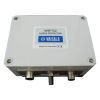Vaisala WSP150 Surge Protector
Features
- Can be used with all Vaisala wind and weather instruments
- Superior three-stage, transient surge protection
- Tolerates up to 10 kA surge currents
- Free ground shipping
- Expedited repair and warranty service
- Lifetime technical support
- More
Overview
The Vaisala WSP150 Surge Protector is a compact transient overvoltage suppressor designed for outdoor use. It can be used with all Vaisala wind and weather instruments. The WSP150 offers three-stage protection against surge currents up to 10 kA entering through the power and signal cables.
Mechanics
The Vaisala WSP150 Surge Protector has four channels, two of which are dedicated to power lines and two for data lines. Each channel uses a three-stage protection scheme as follows: first, there are discharge tubes, then voltage-dependent resistors (VDR), and finally, transient zener diodes. Between each stage, there are either series inductors or resistors. Both differential and common mode protection is provided for each channel: across the wire pairs, against the operating voltage ground, and against the earth. The WSP150 also includes noise filtering against HF and RF interference.
Applications
Vaisala recommends using the WSP150 when wind and weather instruments are installed on top of high buildings or masts and in open grounds, that is, anywhere with an elevated risk of lightning. Also, use the WSP150 if the cable length exceeds 30m or if users have unshielded, open-wire lines.
- (1) WSP150 surge protector
- (1) Adjustable mounting clamp
In The News
Vaisala WXT520: Weather station designed with monitoring systems in mind
The world’s weather is full of surprises. That makes a quality weather station a valuable piece of technology for monitoring systems. Vaisala's WXT520 multiparameter weather station is built with monitoring systems in mind. It monitors six weather parameters in real time, so users have the numbers on an unexpected rain storm or turbulent wind event. It can be a means of understanding weather events that caused a flush of nitrogen into a river or low water levels in a lake. What’s more, with the help of a data logger and telemetry system, it can deliver that information to one’s desk so she can stay dry and keep an eye on the data during a storm. Three core components make up Vaisala’s WXT520 weather station.
Read MoreFrom Hurricanes to Florida’s Red Tides: Monitoring the Southwest Gulf Coast
Nearly every year, southwest Florida is blighted by harmful Karenia brevis blooms–known colloquially as Florida red tides. These harmful algal blooms (HABs) form over the West Florida shelf and are pushed shorewards by winds and currents. Once in touching distance of the coast, they often intensify, fed by land-based runoff, anthropogenic nutrients, and decomposing marine life killed by toxins produced by these red tides. Red tides have become more severe and persistent over the past 20 years, causing major environmental and economic damage.
Read MoreWave-Powered Buoy Deployed in Puget Sound
While the development of solar-powered monitoring systems has improved access to real-time environmental data, solar power is still limited by low light conditions, such as poor weather, nighttime, or high-latitude environments. To supplement these incumbent power solutions at sea, Ocean Motion Technologies has developed a small-scale ocean wave energy system that can be directly integrated with existing data buoy platforms. Not only does wave energy supplement solar power during periods when the buoys are limited by light availability, but it also allows data buoys to perform beyond their current power capacities.
Read More







